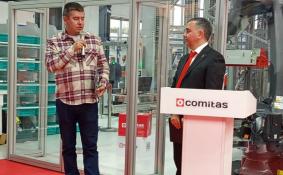Scientific & Practical Journal

Editorial News
Dear readers! We are pleased to present to you the eleventh issue of the journal in 2025. There are a lot of relevant and useful materials in the issue, which, hopefully, will not be ignored.
Dear readers! In September the CeMAT RUSSIA exhibition was held, which showed everyone that innovations and robotics are increasingly penetrating the logistics industry. We can safely say that many technologies are tested here, and only then they go out into the world. However, it is not only CeMAT RUSSIA that demonstrates the prevalence of the digital agenda.
Dear readers! This is the ninth issue of the journal, which turned out to be very rich and diverse. Traditionally, the issue is opened by an analyst. The material by Alina Nasyrova from the Market Guide Agency, dedicated to investments in warehouse complexes in Russia, recalls the importance of developing logistics infrastructure for the integrated development of regions.
PHOTO OF THE WEEK
CITATIONS
All News of Logistics
‘Green’ property stock in Russia surpasses 3.6m sq m, according to JLL
MOSCOW, 07 December, 2016 – JLL has presented the results of its regular study ‘Sustainability and Green Development in Russia’. Over the last two years the volume of real estate certified to international sustainability standards has nearly doubled, increasing by 1.7m sq m since 2014 and now totaling over 3.6m sq m.
According to JLL, a record-breaking amount of real estate, 1.1m sq m, was certified under international standards in 2015. In Q1-Q3 2016, the total amount of ‘green’ real estate has increase by 627,000sq m.
“Last year’s peak had to do with completed certification of a number of large projects, including stadiums and warehouses,” – Ksenia Agapova, Head of Sustainability Services, JLL, Russia & CIS, says. – “In 2016 there have been fewer properties of that kind among certified objects, and new construction generally slowed within the country, hence the more modest results we see now. Nonetheless, most developers today consider environmental certification as a part of standard practice for their new construction projects.”
The Moscow Region has the highest amount of certified buildings: with a total of more than 2.2m sq m, or 54 properties. St. Petersburg is second with 310,000 sq m, or 13 properties.
Most (1.2m sq m—more than a third) of the certified space is offices. Second place goes to warehouses/industrial assets and sports objects, with 0.8m sq m, 23%, in each category.
“It was foreign market players who had stipulated the culture of environmental certification in Russia, especially international tenants interested in energy-saving and healthy offices and, to a lesser extent, warehouses. The share of retail space had increased significantly over past few years: in 2014 such objects comprised only 2% of the ‘green’ market in Russia, but by the end of Q3 2016 their portion increased to 15%, and we expect it to grow more.” – Ksenia Agapova notes.
Retail makes up about half (370,000 sq m) of all properties certified in Q1-Q3 2016. Shopping centre developers and retailers are becoming more interested in certifying to ‘green’ building standards, it is a distinctive trend, which has to do with changes in legislation in the West and social and environmental reporting to which many multinational retailers are bound to submit.
Despite the doubling of the ‘green’ market over the last two years, it is still a small portion of the overall commercial real estate market. In Moscow, about 5% of offices are certified, as are 6% of warehouses, in St. Petersburg the figure is under 7% for offices and zero for industrial premises. There is certainly room for ‘green’ growth, says JLL.
“The overall tendency is obviously positive: owners and tenants of retail properties increasingly consider their energy efficiency and international certification as high priority. For Class A offices, LEED or BREEAM certificates become a must have. Judging by the projects our team is currently certifying, we can predict further expansion of this market to 700,000 sq m in 2017.” – Ksenia Agapova concludes.












